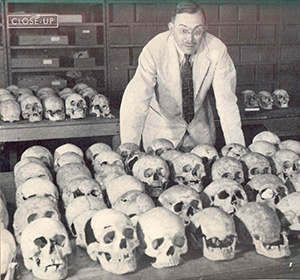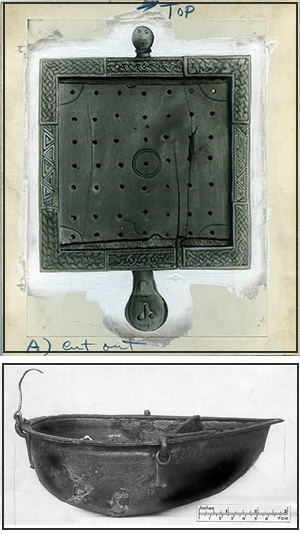ARCHAEOLOGY & EUGENICS: Harvard, Celtic skulls and eugenics in de Valera’s Ireland
Published in 20th Century Social Perspectives, Features, Issue 5 (September/October 2018), Volume 26The Harvard Archaeological Mission to Ireland, 1932–6.
By Mairéad Carew
The driving force behind the Harvard Archaeological Mission to Ireland was eugenics, now considered a pseudo-science and a variant of scientific racism. It was then regarded as the science of better breeding for human beings and had been established as a discipline in several universities across the world. The Harvard Archaeological Mission was one of the strands in an anthropological survey that also included the physical examination of thousands of people across Ireland and a social survey of Irish people in County Clare. Ancient skulls were compared with modern ones in an effort to establish who the Celts were, where they had originated and who their descendants were among modern Irish people.

Above: The overall manager of the Harvard Archaeological Mission to Ireland, anthropologist Earnest A. Hooton, with skulls used in his research. (Life, 1 January 1936)
Anthropology and eugenics
The overall manager of the Harvard Mission was Earnest A. Hooton. He was one of the leading physical anthropologists in America at the time and was in charge of the bone lab at the Peabody Museum at Harvard, which contained human skulls from all over the world. He was also an influential advocate of eugenics and an active member of the American Eugenics Society. This society supported Germany’s eugenics programme in the 1930s, although Hooton claimed that he did not personally support the Nazis. He did, however, want to set up an American national breeding bureau and was eventually disciplined by Harvard University for his ‘inhuman’ teachings. Harsh new immigration laws had been enacted in the 1920s, after vigorous lobbying by eugenicists, in an effort to keep ‘defectives’ out. Potential immigrants to the United States were ‘eugenically inspected’. American anthropologists carried out investigations in Belgium, Britain, Norway, Sweden, Denmark, Czechoslavakia, Italy, Holland, Poland and Germany, as well as the Irish Free State.
One of the reasons that Hooton chose Ireland for an anthropological survey was because the inhabitants still spoke a Celtic language, ‘an ancient Aryan language once spoken all over Europe’. Eoin MacNeill had embarked on a study tour of American universities in 1930 in an effort to promote Celtic Studies and also to attract funding for scientific Celtic research in Ireland. James McGurrin, president-general of the American Irish Historical Society of New York, acknowledged that the growing interest in things Celtic had produced a large body of research work, ‘and its highest practical expression is seen in the work of the Harvard University Archaeological Mission’.
The Harvard Mission anthropologists measured c. 12,000 people in the 32 counties of Ireland. Hair and eye colour, skull shape and stature were examined to determine racial characteristics. The Irish were considered to be ‘Celtic’ and therefore a pure race, and this racial inheritance was very significant to Irish-Americans. They contributed financially to the Harvard Mission project, the bulk of the funding coming from a Rockefeller Foundation grant. This was organised by Alfred Marston Tozzer, head of the Anthropology Department at Harvard. He visited Ballinderry 2 crannog in County Offaly in 1933 during the second Harvard archaeological expedition with the intention of establishing an American School of Celtic Studies centred on the site. The peculiar thing about this is that Tozzer was not a specialist in European or Celtic archaeology but was a curator of Middle American/Mayan archaeology. He had served as the director of the International School of American Archaeology in Mexico and was involved in a spy scandal there, where American archaeologists worked as intelligence officers during the First World War. During the Second World War Tozzer became the director of the Honolulu office of the Office of Strategic Services (OSS, forerunner of the CIA).

Above: While the ideology driving the Harvard Mission was suspect, the careful excavations and recovery of artefacts—including this tenth-century Viking gaming board (above) and Early Christian bronze hanging bowl (left) from Ballinderry 1 crannog, Co. Westmeath—were at the cutting edge of archaeological science at the time. (NMI)
The archaeologists and the artefacts
Like their colleague Tozzer, the director of the Harvard Archaeological Mission, Hugh O’Neill Hencken, and the assistant director, Hallam L. Movius, were also involved in American intelligence during the Second World War. Movius joined the US Army air force in 1942 and became an intelligence officer in Italy. Hencken joined the American Defence Harvard Group, which collaborated with the OSS and compiled manuals on totalitarianism and Nazism, and was involved in the protection of historic monuments in war areas. It is not known, however, whether they were involved in intelligence-gathering while working in Ireland.
Hencken had deep family roots in Ireland. His grandfather had emigrated in the mid-nineteenth century from County Down to New York, where he became a dry goods merchant. The rising fortunes of the family (and perhaps the Irish in general) was reflected in Hencken’s entry to Harvard, where he was later appointed assistant curator of European Archaeology at the Peabody Museum in 1931. Movius, his assistant and Ph.D student, was an expert in the Early Stone Age and excavated Mesolithic sites in counties Antrim, Derry and Down. Sites excavated in the Irish Free State included crannogs, Bronze Age graves, a stone fort, megalithic tombs and cave sites in counties Westmeath, Offaly, Meath, Sligo, Mayo, Clare and Waterford.
While the ideology driving the Harvard Mission was suspect, the careful excavations and recovery of artefacts were at the cutting edge of archaeological science at the time. Thousands of artefacts were recovered. The majority of these came from the crannogs. For example, the objects recovered from Lagore crannog, Co. Meath, included evidence of farming, bronze-working, iron-working, woodworking, glass-making, textile production, shoemaking and weaving. Swords and jewellery were also found. The most iconic objects from the Harvard Mission included a Viking gaming board (dating from the tenth century) and an Early Christian bronze hanging bowl from Ballinderry 1 crannog, Co. Westmeath. Both artefacts were considered to be decorated in the ‘Celtic’ style and were sent to the Chicago World Fair in 1934 as part of an Irish Free State cultural exhibition centring on artefacts from the National Museum of Ireland.
Archaeology in de Valera’s Ireland
When de Valera came to power in 1932 he continued the previous government’s nation-building agenda, centring on cultural initiatives to construct, protect and promote a unique identity for the Irish Free State at home and abroad. This process included the framing in 1927 of a new cultural policy document for the National Museum, which prioritised Celtic and Christian artefacts for display; the enacting of legislation to protect national monuments in 1930; the co-founding of the Irish Manuscripts Commission by Eoin MacNeill in 1928; the hosting of the Eucharistic Congress in 1932; the setting up of the Folklore Commission in 1935; and the establishment by de Valera in 1940 of the Institute for Advanced Studies in Dublin, housing a school of Celtic Studies side by side with a school of Theoretical Physics. This unique initiative was modelled on a similar institute at Princeton University in America. The Harvard Archaeological Mission fits very well into the cultural agenda of the Irish Free State in the 1930s and was an important event for the Irish diaspora. During the 1930s, having an identity as white, Celtic and European was politically and economically advantageous for Irish people as potential immigrants to the United States.
De Valera took a personal interest in the excavations by the Harvard Archaeological Mission and visited many of the sites. All of the scientific reports were sent directly to him. He instigated the Unemployment Schemes for Archaeological Research in Ireland in 1934. This was influenced by a similar scheme introduced by F.D. Roosevelt to alleviate unemployment in America. The Harvard Mission archaeological project benefited from this initiative, as labour costs were met by the Irish Free State government. For example, unemployed men worked at Lagore crannog in County Meath for three seasons between 1934 and 1936, and local men were also employed at Kilgreany cave in County Waterford, excavated by Movius in 1934.
Answering questions about the Celts
The Harvard team arrived in Ireland with the belief that the identity of the Irish was Celtic and they left asserting that they had found a Celtic type in Ireland. They used the word ‘type’ rather than ‘race’ in their physical anthropology report, published in the 1950s, as ideas about race had been discredited after the Second World War. In an article on Hooton, published in Life magazine in 1939, it was reported that ‘No long-upper-lipped, baboon-faced Irishmen common in political cartoons were found’. When Hugh O’Neill Hencken died in 1981, the New York Times reported that he had come to Ireland in the 1930s and found a Celtic house in Ballinderry. It was known in the 1930s, however, that Ireland had not been invaded by Celts. The idea of a Celtic invasion persisted, however, and eventually in 2006 Barry Raftery, Professor of Celtic Archaeology at UCD, stated bluntly that ‘there is simply no evidence of invading Celts’. The invasion of the Celts was a cultural idea and not a scientific reality. The label ‘Celtic’ is continually adapted to reflect a changing political and cultural landscape in Ireland.
Mairéad Carew is an archaeologist and cultural historian.
Read More:
The Nazi in the Museum
FURTHER READING
- Carew, The quest for the Irish Celt: the Harvard Archaeological Mission to Ireland, 1932–1936 (Dublin, 2018).
















